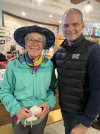Bad Pilgrim
Veteran Member
- Time of past OR future Camino
- Yes
Dear people,
I walked my annual Camino de Invierno between the 11 and the 18 of July this year (2022). I kept a diary of which I publish a summary below. You will get it in bits because it is too long to read… Expletives, wild animal attacks and revelling in napolitanas have been left out. First a few general notes and a comparison with last year's Invierno:
Kilometers: The distance to Santiago is now engraved on the mojones (the granite waymarks). The distance was not there last year (beginning of July 2021). Everything looks brand new and no mojón has been damaged/defaced - except one. I think you can guess which one. We will get to that later.
Embellishment: The Xunta and/or the villagers really stepped up since last year. The places where the Camino goes have been prettified. One example: there is now a Pilgrim's Bench, Banco peregrino, in several villages and hamlets. It is a large, yellow bench in the shape of an arrow; you will see them when you walk by. There are more info boards, waymarks, signs, quirky handicraft, flowerpots and what have you to emphasize the Camino, especially in the small villages. There is also a sense of general cleanup. Above all, a cleanup of dogs. I imagine the Xunta ushered an order to the villagers to chain the dogs, lock them up, or deport them to the Castilian border. I only met aggressive dogs before Quiroga and Belesar, nowhere else.
Wildfires? I was lucky not to experience any of it. Less than a week later (July 18) I see the Valdeorras region, Quiroga and Pobra do Brollón having problems. Trains between Galicia and Madrid have been cancelled or substituted with other means of transport. Watch the news and ask the locals if the Camino de Invierno is affected, if you are walking any time soon!
But let's get down to business.
Day 0: Ponferrada. I arrived with the night bus from Mérida at 9.30 a.m. I stayed at Hostal Río Selmo, 35 euros. The cheapest alternatives are of course the albergues San Nicolás de Flüe (parochial), Alea (private) and Guiana (private) but I can't stand the snoring. Guiana has an amazing breakfast (in 2018 when I stayed there) if you are into those kinds of things. I spent large part of the day in the cafés in the old town watching pilgrims arrive. They wear their bathroom, kitchen and livingroom on their backs, and judging by their boots they plan to walk through the Amazon jungle. I got tendonitis just by looking at them. I wanted to run some errands to Decathlon. But it was Sunday and it was closed, as was much of the rest of town… I went to bed early to be well rested before my first stage the following day.
To be continued
I walked my annual Camino de Invierno between the 11 and the 18 of July this year (2022). I kept a diary of which I publish a summary below. You will get it in bits because it is too long to read… Expletives, wild animal attacks and revelling in napolitanas have been left out. First a few general notes and a comparison with last year's Invierno:
Kilometers: The distance to Santiago is now engraved on the mojones (the granite waymarks). The distance was not there last year (beginning of July 2021). Everything looks brand new and no mojón has been damaged/defaced - except one. I think you can guess which one. We will get to that later.
Embellishment: The Xunta and/or the villagers really stepped up since last year. The places where the Camino goes have been prettified. One example: there is now a Pilgrim's Bench, Banco peregrino, in several villages and hamlets. It is a large, yellow bench in the shape of an arrow; you will see them when you walk by. There are more info boards, waymarks, signs, quirky handicraft, flowerpots and what have you to emphasize the Camino, especially in the small villages. There is also a sense of general cleanup. Above all, a cleanup of dogs. I imagine the Xunta ushered an order to the villagers to chain the dogs, lock them up, or deport them to the Castilian border. I only met aggressive dogs before Quiroga and Belesar, nowhere else.
Wildfires? I was lucky not to experience any of it. Less than a week later (July 18) I see the Valdeorras region, Quiroga and Pobra do Brollón having problems. Trains between Galicia and Madrid have been cancelled or substituted with other means of transport. Watch the news and ask the locals if the Camino de Invierno is affected, if you are walking any time soon!
But let's get down to business.
Day 0: Ponferrada. I arrived with the night bus from Mérida at 9.30 a.m. I stayed at Hostal Río Selmo, 35 euros. The cheapest alternatives are of course the albergues San Nicolás de Flüe (parochial), Alea (private) and Guiana (private) but I can't stand the snoring. Guiana has an amazing breakfast (in 2018 when I stayed there) if you are into those kinds of things. I spent large part of the day in the cafés in the old town watching pilgrims arrive. They wear their bathroom, kitchen and livingroom on their backs, and judging by their boots they plan to walk through the Amazon jungle. I got tendonitis just by looking at them. I wanted to run some errands to Decathlon. But it was Sunday and it was closed, as was much of the rest of town… I went to bed early to be well rested before my first stage the following day.
To be continued
Last edited:





























